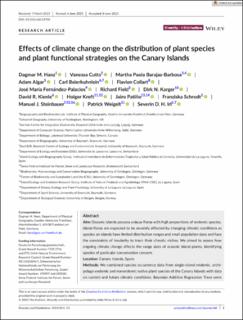| dc.contributor.author | Hanz, Dagmar M. | |
| dc.contributor.author | Cutts, Vanessa | |
| dc.contributor.author | Barajas-Barbosa, Martha Paola | |
| dc.contributor.author | Algar, Adam | |
| dc.contributor.author | Beierkuhnlein, Carl | |
| dc.contributor.author | Collart, Flavien | |
| dc.contributor.author | Fernández-Palacios, José María | |
| dc.contributor.author | Field, Richard | |
| dc.contributor.author | Karger, Dirk N. | |
| dc.contributor.author | Kienle, David R. | |
| dc.contributor.author | Kreft, Holger | |
| dc.contributor.author | Patiño, Jairo | |
| dc.contributor.author | Schrodt, Franziska | |
| dc.contributor.author | Steinbauer, Manuel | |
| dc.contributor.author | Weigelt, Patrick | |
| dc.contributor.author | Irl, Severin D. H. | |
| dc.date.accessioned | 2023-08-14T11:21:01Z | |
| dc.date.available | 2023-08-14T11:21:01Z | |
| dc.date.created | 2023-07-12T12:12:35Z | |
| dc.date.issued | 2023 | |
| dc.identifier.issn | 1366-9516 | |
| dc.identifier.uri | https://hdl.handle.net/11250/3083828 | |
| dc.description.abstract | Aim
Oceanic islands possess unique floras with high proportions of endemic species. Island floras are expected to be severely affected by changing climatic conditions as species on islands have limited distribution ranges and small population sizes and face the constraints of insularity to track their climatic niches. We aimed to assess how ongoing climate change affects the range sizes of oceanic island plants, identifying species of particular conservation concern.
Location
Canary Islands, Spain.
Methods
We combined species occurrence data from single-island endemic, archipelago endemic and nonendemic native plant species of the Canary Islands with data on current and future climatic conditions. Bayesian Additive Regression Trees were used to assess the effect of climate change on species distributions; 71% (n = 502 species) of the native Canary Island species had models deemed good enough. To further assess how climate change affects plant functional strategies, we collected data on woodiness and succulence.
Results
Single-island endemic species were projected to lose a greater proportion of their climatically suitable area (x ̃ = −0.36) than archipelago endemics (x ̃ = −0.28) or nonendemic native species (x ̃ = −0.26), especially on Lanzarote and Fuerteventura, which are expected to experience less annual precipitation in the future. Moreover, herbaceous single-island endemics were projected to gain less and lose more climatically suitable area than insular woody single-island endemics. By contrast, we found that succulent single-island endemics and nonendemic natives gain more and lose less climatically suitable area.
Main Conclusions
While all native species are of conservation importance, we emphasise single-island endemic species not characterised by functional strategies associated with water use efficiency. Our results are particularly critical for other oceanic island floras that are not constituted by such a vast diversity of insular woody species as the Canary Islands. | en_US |
| dc.language.iso | eng | en_US |
| dc.publisher | Wiley | en_US |
| dc.rights | Navngivelse 4.0 Internasjonal | * |
| dc.rights.uri | http://creativecommons.org/licenses/by/4.0/deed.no | * |
| dc.title | Effects of climate change on the distribution of plant species and plant functional strategies on the Canary Islands | en_US |
| dc.type | Journal article | en_US |
| dc.type | Peer reviewed | en_US |
| dc.description.version | publishedVersion | en_US |
| dc.rights.holder | Copyright 2023 The Author(s) | en_US |
| cristin.ispublished | true | |
| cristin.fulltext | original | |
| cristin.qualitycode | 2 | |
| dc.identifier.doi | 10.1111/ddi.13750 | |
| dc.identifier.cristin | 2162109 | |
| dc.source.journal | Diversity and Distributions: A journal of biological invasions and biodiversity | en_US |
| dc.identifier.citation | Diversity and Distributions: A journal of biological invasions and biodiversity. 2023. | en_US |

